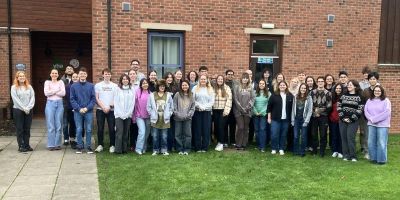Why social stress is fatal for fruit flies

Stressed out fruit flies could be dying sooner because their social lives affect their biology, new research shows.
Fruit flies are already known to live shorter, unhealthier lives when they have more stressful social contact, such as males being grouped together, or females grouped with males, but the reason behind this was unknown.
Scientists led by the University of Leeds believe the answer could lie in the collection of microorganisms living within the fly’s body. Known as the microbiome, it affects a range of traits including development, metabolism, immune responses and longevity. Healthy bodies have healthy microbiomes and vice versa.
They found that flies who experienced stressful social environments had the biggest change in the microbiome - suggesting a biological link between social stress, immunity and longevity.
"We hope in the future we can use flies as a model to understand the molecular mechanisms that link social environments, the microbiome and health.”
Co-lead author Laurin McDowall, research fellow in the University of Leeds’ School of Biology, said: “It’s interesting that different social manipulations have different effects. This might reflect which types of interactions are stressful or beneficial to the flies.”
The scientists focused on one species of fruit fly called Drosophila melanogaster, commonly used in research because they have about 75% of the same genes known to cause disease as humans. Together with their rapid life cycle and large number of offspring, this makes them ideal subjects for the quick study of disease.
The researchers set out to discover whether the fly’s social environment leads to an alteration in their microbiome, either by transfer of bacteria from fly to fly, or by the effect of social contact on the flies’ immune and stress responses. Social stress is known to impact immune responses in both fruit flies and humans.
Social flies
The team looked at a range of social environments, including different groupings of larvae; placing an ageing fly with a group of younger flies; grouping flies of the same age together, or with a same-sex partner. They found that flies who emerged from larvae grouped with adult males had shorter lives, while adult males kept with other males had shorter lives and were worse at surviving infection. Crucially, these groups also showed changes in their microbiome.
However, social grouping or isolation had little effect on the microbiome of adult females.
As the microbiome is already known to have important effects on host ageing, these new findings may provide a link between stressful environments and health.
Tom Leech co-led the research while a PhD student in Leeds’ School of Biology.
Now a Post-Doctoral researcher at the Max Planck Institute for Biology of Ageing, he said: “Our research suggests that the transference of bacteria between flies is not the only cause of microbiome changes. If this was the case, we would expect males and females to show the same microbiome responses to grouping, but they don’t - meaning something else is at play.
“We observed that the same social manipulations that alter lifespan also alter the microbiome, indicating a link between the two.”
Human link
Senior author Dr Amanda Bretman, Associate Professor in Behavioural Ecology in Leeds’ School of Biology, said: “This work fits with the idea that the gut-brain axis - communication between the host brain and gut microbes through hormones and nerves - alters how the host responds to environmental stress. We need to find out if there is really a causal relationship.
“Social environments have been shown to alter human health and wellbeing, and their microbiome. Although our study does not have immediate applications to humans, we hope in the future we can use flies as a model to understand the molecular mechanisms that link social environments, the microbiome and health.”
Further information
The study, ‘Social environment drives sex and age-specific variation in Drosophila melanogaster microbiome composition and predicted function’, was published on 8 September 2021 in Molecular Ecology. It was funded by the Royal Society and the University of Leeds.
For media enquiries contact University of Leeds press officer Lauren Ballinger




